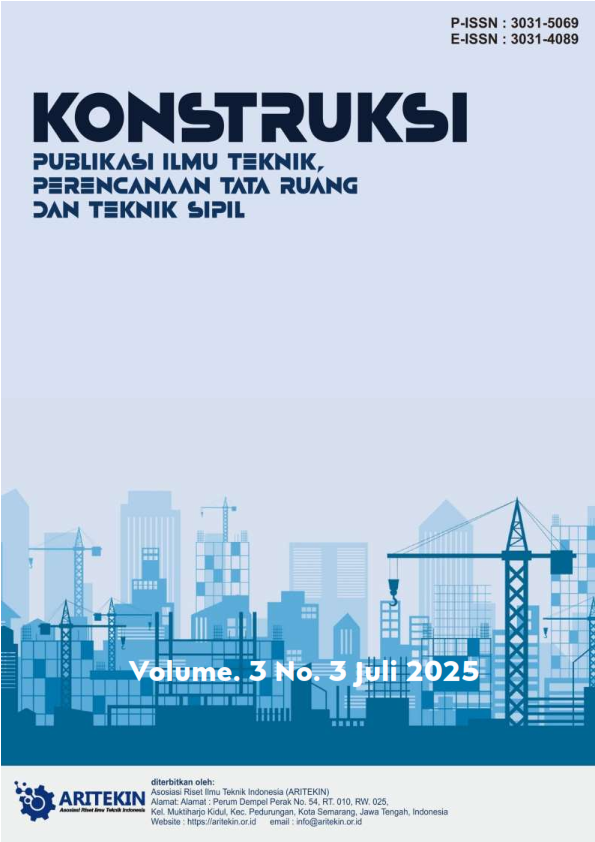Strategi Pengembangan TPU Dosay sebagai Ruang Terbuka Hijau Berbasis Persepsi Masyarakat dan Analisis SWOT-AHP
DOI:
https://doi.org/10.61132/konstruksi.v3i3.875Keywords:
Green Open Space, Dosay Cemetery, Community Perception, Development Strategy, SWOT, AHPAbstract
Limited land in the urban area of Jayapura Regency is a major challenge in the provision of Green Open Space (RTH), even though the existence of RTH is very important to maintain ecological balance and the quality of the community's living environment. In this context, the Dosay Public Cemetery (TPU) has great potential to be optimized as an alternative green space that is multifunctional-ecological, social, and aesthetic. This study aims to assess community perceptions of the utilization of TPU Dosay as a green space, as well as to formulate a strategy for its sustainable development. The approach used was mixed methods, with data collection through a survey using a Likert scale to 35 respondents, open interviews with 9 key informants, as well as SWOT and AHP analysis. The results showed that most people support the development of TPU Dosay as a reflective green space that is comfortable and ecologically valuable. From the results of AHP analysis, policy and regulation aspects are the top priorities in the development strategy, followed by vegetation and accessibility aspects. Strategic recommendations include the preparation of adaptive vegetation zoning, strengthening the local policy framework, active involvement of indigenous communities, and cross-sector collaboration between local governments, academics and the private sector. With the right strategy, the development of TPU Dosay is expected to be an innovative solution in overcoming the shortage of green spaces in Jayapura Regency.
References
Artmann, M., Bastian, O., & Grunewald, K. (2019). Using green infrastructure for urban planning in Europe. Urban Forestry & Urban Greening, 40, 123–134.
Budihardjo, E. (2015). Perencanaan kota dan wilayah. Gadjah Mada University Press.
Carr, S., Francis, M., Rivlin, L. G., & Stone, A. M. (2017). Public space. Cambridge University Press.
Chiesura, A. (2004). The role of urban parks for sustainable city. Landscape and Urban Planning, 68(1), 129–138. https://doi.org/10.1016/j.landurbplan.2003.08.003
Creswell, J. W. (2014). Research design: Qualitative, quantitative, and mixed methods approaches (4th ed.). Sage Publications.
Direktorat Jenderal Penataan Ruang. (2018). Pedoman penyediaan ruang terbuka hijau di kawasan perkotaan. Kementerian ATR/BPN.
Hakim, R. (2016). Optimalisasi ruang terbuka hijau kota. Jurnal Arsitektur Lanskap Tropis, 4(2), 22–31.
Kabisch, N., Korn, H., Stadler, J., & Bonn, A. (2017). Nature-based solutions to climate change adaptation in urban areas. Springer.
Kusuma, A. (2019). Optimalisasi TPU sebagai RTH. Jurnal Tata Ruang Kota, 11(2), 45–53.
Organisasi Kesehatan Dunia. (2016). Ruang terbuka hijau perkotaan dan kesehatan. Kantor Regional WHO untuk Eropa. https://www.euro.who.int/__data/assets/pdf_file/0005/321971/Urban-green-spaces-and-health-review-evidence.pdf
Peraturan Menteri Pekerjaan Umum No. 05/PRT/M/2008 tentang Pedoman penyediaan dan pemanfaatan ruang terbuka hijau di kawasan perkotaan. (2008). Kementerian Pekerjaan Umum.
Peraturan Pemerintah No. 9 Tahun 1987 tentang Penyediaan dan penggunaan tanah untuk keperluan pemakaman. (1987). Lembaran Negara Republik Indonesia.
Purnomohadi, N. (2006). Ruang terbuka hijau di perkotaan. Direktorat Jenderal Penataan Ruang.
Sadyohutomo, T. A. (2016). Strategi penataan ruang hijau perkotaan. Jurnal Lanskap Tropika, 3(1), 1–9.
Shirvani, H. (2015). The urban design process (3rd ed.). Van Nostrand Reinhold.
Simonds, J. O. (2006). Landscape architecture: A manual of environmental planning and design (4th ed.). McGraw-Hill.
Sugiyono. (2017). Metode penelitian kombinasi (mixed methods). Alfabeta.
Undang-Undang Republik Indonesia Nomor 26 Tahun 2007 tentang Penataan Ruang. (2007). Lembaran Negara Republik Indonesia Tahun 2007 Nomor 68.
Uslu, A., Erdoğan, E., & Dikmen, N. (2009). Cemetery planning and its roles in urban ecosystems. Environmental Planning Journal, 14(2), 45–53.
Zhou, Q., Zhao, Y., & Jiang, Y. (2021). Evaluating the multifunctionality of urban green space: A review of the literature. Journal of Urban Planning and Development, 147(2), 05021007.
Downloads
Published
How to Cite
Issue
Section
License
Copyright (c) 2025 Konstruksi: Publikasi Ilmu Teknik, Perencanaan Tata Ruang dan Teknik Sipil

This work is licensed under a Creative Commons Attribution-ShareAlike 4.0 International License.






